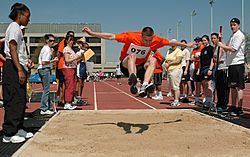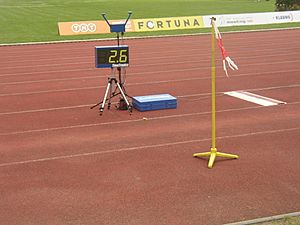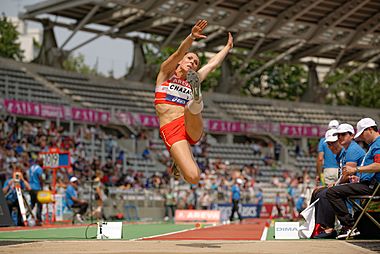Long jump facts for kids

The long jump is a sport in athletics (track and field), where athletes compete by comparing lengths of their jumps where athletes try to jump as far as they can. For this, the athlete runs down the runway to the jumping pit which is made of soft sand If a person falls backwards when jumping, this can decrease the length of their jump.
Contents
Rules
At the elite level, competitors run down a runway (usually coated with the same rubberized surface as running tracks, crumb rubber also vulcanized rubber—known generally as an all-weather track) and jump as far as they can from a wooden board 20 cm or 8 inches wide that is built flush with the runway into a pit filled with finely ground gravel or sand. If the competitor starts the leap with any part of the foot past the foul line, the jump is declared a foul and no distance is recorded. A layer of plasticine is placed immediately after the board to detect this occurrence. An official (similar to a referee) will also watch the jump and make the determination. The competitor can initiate the jump from any point behind the foul line; however, the distance measured will always be perpendicular to the foul line to the nearest break in the sand caused by any part of the body or uniform. Therefore, it is in the best interest of the competitor to get as close to the foul line as possible. Competitors are allowed to place two marks along the side of the runway in order to assist them to jump accurately. At a lesser meet and facilities, the plasticine will likely not exist, the runway might be a different surface or jumpers may initiate their jump from a painted or taped mark on the runway. At a smaller meet, the number of attempts might also be limited to four or three.
Each competitor has a set number of attempts. That would normally be three trials, with three additional jumps being awarded to the best 8 or 9 (depending on the number of lanes on the track at that facility, so the event is equatable to track events) competitors. All legal marks will be recorded but only the longest legal jump counts towards the results. The competitor with the longest legal jump (from either the trial or final rounds) at the end of competition is declared the winner. In the event of an exact tie, then comparing the next best jumps of the tied competitors will be used to determine place. In a large, multi-day elite competition (like the Olympics or World Championships), a set number of competitors will advance to the final round, determined in advance by the meet management. A set of 3 trial round jumps will be held in order to select those finalists. It is standard practice to allow at a minimum, one more competitor than the number of scoring positions to return to the final round, though 12 plus ties and automatic qualifying distances are also potential factors. (For specific rules and regulations in United States Track & Field see Rule 185).
For record purposes, the maximum accepted wind assistance is two metres per second (m/s) (4.5 mph).
Technique
There are five main components of the long jump: the approach run, the last two strides, takeoff, action in the air, and landing. Speed in the run-up, or approach, and a high leap off the board are the fundamentals of success. Because speed is such an important factor of the approach, it is not surprising that many long jumpers also compete successfully in sprints. A classic example of this long jump / sprint doubling are performances by Carl Lewis.
The approach
The objective of the approach is to gradually accelerate to a maximum controlled speed at takeoff. The most important factor for the distance travelled by an object is its velocity at takeoff – both the speed and angle. Elite jumpers usually leave the ground at an angle of twenty degrees or less; therefore, it is more beneficial for a jumper to focus on the speed component of the jump. The greater the speed at takeoff, the longer the trajectory of the center of mass will be. The importance of a takeoff speed is a factor in the success of sprinters in this event.
The length of the approach is usually consistent distance for an athlete. Approaches can vary between 12 and 19 strides on the novice and intermediate levels, while at the elite level they are closer to between 20 and 22 strides. The exact distance and number of strides in an approach depends on the jumper's experience, sprinting technique, and conditioning level. Consistency in the approach is important as it is the competitor's objective to get as close to the front of the takeoff board as possible without crossing the line with any part of the foot.
Inconsistent approaches are a common problem in the event. As a result, the approach is usually practiced by athletes about 6–8 times per jumping session (see Training below).
The last two strides
The objective of the last two strides is to prepare the body for takeoff while conserving as much speed as possible.
The penultimate stride is longer than the last stride. The competitor begins to lower his or her center of gravity to prepare the body for the vertical impulse. The final stride is shorter because the body is beginning to raise the center of gravity in preparation for takeoff.
The last two strides are extremely important because they determine the velocity with which the competitor will enter the jump.
Takeoff
The objective of the takeoff is to create a vertical impulse through the athlete's center of gravity while maintaining balance and control.
This phase is one of the most technical parts of the long jump. Jumpers must be conscious to place the foot flat on the ground, because jumping off either the heels or the toes negatively affects the jump. Taking off from the board heel-first has a braking effect, which decreases velocity and strains the joints. Jumping off the toes decreases stability, putting the leg at risk of buckling or collapsing from underneath the jumper. While concentrating on foot placement, the athlete must also work to maintain proper body position, keeping the torso upright and moving the hips forward and up to achieve the maximum distance from board contact to foot release.
There are four main styles of takeoff: the kick style, double-arm style, sprint takeoff, and the power sprint or bounding takeoff.
Kick
The kick style takeoff is where the athlete actively cycles the leg before a full impulse has been directed into the board then landing into the pit. This requires great strength in the hamstrings. This causes the jumper to jump to large distances.
Double-arm
The double-arm style of takeoff works by moving both arms in a vertical direction as the competitor takes off. This produces a high hip height and a large vertical impulse.
Sprint
The sprint takeoff is the style most widely instructed by coaching staff. This is a classic single-arm action that resembles a jumper in full stride. It is an efficient takeoff style for maintaining velocity through takeoff.
Power sprint or bounding
The power sprint takeoff, or bounding takeoff, is one of the more common elite styles. Very similar to the sprint style, the body resembles a sprinter in full stride. However, there is one major difference. The arm that pushes back on takeoff (the arm on the side of the takeoff leg) fully extends backward, rather than remaining at a bent position. This additional extension increases the impulse at takeoff.
The "correct" style of takeoff will vary from athlete to athlete.
Action in the air and landing
There are three major flight techniques for the long jump: the hang, the sail, and the hitch-kick. Each technique is to combat the forward rotation experienced from take-off but is basically down to preference from the athlete. It is important to note that once the body is airborne, there is nothing that the athlete can do to change the direction they are traveling and consequently where they are going to land in the pit. However, it can be argued that certain techniques influence an athlete's landing, which can affect the distance measured. For example, if an athlete lands feet first but falls back because they are not correctly balanced, a lower distance will be measured.
In the 1970s some jumpers used a forward somersault, including Tuariki Delamere who used it at the 1974 NCAA Championships, and who matched the jump of the current Olympic champion Randy Williams. The somersault jump has potential to produce longer jumps than other techniques because in the flip, no power is lost countering forward momentum, and it reduces wind resistance in the air. The front flip jump was subsequently banned due to fear of it being unsafe.
Training
The long jump generally requires training in a variety of areas. These areas include: speed work, jumping, over distance running, weight training, plyometric training.
Speed work
Speed work is essentially short distance speed training where the athlete would be running at top or near top speeds. The distances for this type of work would vary between indoor and outdoor season but are usually around 30–60 m for indoors and up to 100 m for outdoors.
Jumping
Long Jumpers tend to practice jumping 1–2 times a week. Approaches, or run-throughs, are repeated sometimes up to 6–8 times per session. Short approach jumps are common for jumpers to do, as it allows for them to work on specific technical aspects of their jumps in a controlled environment. Using equipment such as low hurdles and other obstacles are common in long jump training, as it helps the jumper maintain and hold phases of their jump. As a common rule, it is important for the jumper to engage in full approach jumps at least once a week, as it will prepare the jumper for competition.
Over-distance running
Over-distance running workouts helps the athlete jump a further distance than their set goal. For example, having a 100 m runner practice by running 200 m repeats on a track. This is specifically concentrated in the season when athletes are working on building endurance. Specific over-distance running workouts are performed 1–2 times a week. This is great for building sprint endurance, which is required in competitions where the athlete is sprinting down the runway 3–6 times. Typical workouts would include 5×150 m. Preseason workouts may be longer, including workouts like 6×300 m
Weight training
During pre-season training and early in the competition season weight training tends to play a major role in the sport. It is customary for a long jumper to weight train up to 4 times a week, focusing mainly on quick movements involving the legs and trunk. Some athletes perform Olympic lifts in training. Athletes use low repetition and emphasize speed to maximize the strength increase while minimizing adding additional weight to their frame. Important lifts for a long jumper include the back squat, front squat, power cleans and hang cleans. The emphasis on these lifts should be on speed and explosive as those are crucial in the long jump take off phase.
Plyometrics
Plyometrics, including running up and down stairs and hurdle bounding, can be incorporated into workouts, generally twice a week. This allows an athlete to work on agility and explosiveness. Other plyometric workouts that are common for long jumpers are box jumps. Boxes of various heights are set up spaced evenly apart and jumpers can proceed jumping onto them and off moving in a forward direction. They can vary the jumps from both legs to single jumps. Alternatively, they can set up the boxes in front of a high jump mat if allowed, and jump over a high jump bar onto the mat mimicking a landing phase of the jump. These plyometric workouts are typically performed at the end of a workout.
Bounding
Bounding is any sort of continuous jumping or leaping. Bounding drills usually require single leg bounding, double-leg bounding, or some variation of the two. The focus of bounding drills is usually to spend as little time on the ground as possible and working on technical accuracy, fluidity, and jumping endurance and strength. Technically, bounding is part of plyometrics, as a form of a running exercise such as high knees and butt kicks.
Flexibility
Flexibility is an often forgotten tool for long jumpers. Effective flexibility prevents injury, which can be important for high-impact events such as the long jump. It also helps the athlete sprint down the runway. Hip and groin injuries are common for long jumpers who may neglect proper warm-up and stretching.
Hurdle mobility drills are a common way that jumpers improve flexibility. Common hurdle drills include setting up about 5–7 hurdles at appropriate heights and having athletes walk over them in a continuous fashion. Other variations of hurdle mobility drills are used as well, including hurdle skips. This is a crucial part of a jumper's training since they perform most exercises for a very short period of time and often aren't aware of their form and technique. A common tool in many long jump workouts is the use of video taping. This enables the athlete to go back and watch their own progress as well as letting the athlete compare their own footage to that of some of the world-class jumpers.
Related pages
Images for kids
-
Sand pit where Bob Beamon set the 8.90 m record in Mexico City
See also
 In Spanish: Salto de longitud para niños
In Spanish: Salto de longitud para niños








